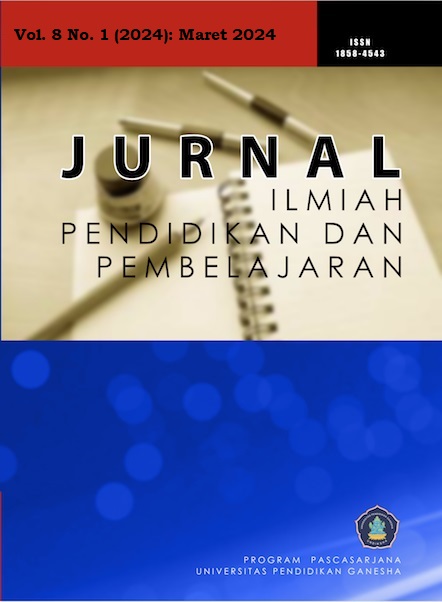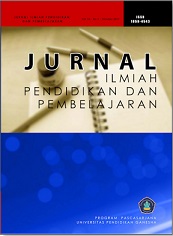Innovative Physical Education Learning: A Collaborative Teamwork Model with Video Support
DOI:
https://doi.org/10.23887/jipp.v8i1.69242Keywords:
Collaborative Teamwork, Learning Model, Physical EducationAbstract
The problems experienced by students in physical education learning are not only limited to problems in aspects of knowledge, but also in aspects of attitudes and skills. The purpose of this study is to develop a physical education learning model based on collaborative teamwork learning assisted by learning videos. This type of research is development research using the ADDIE development model. The research subjects consisted of four groups, namely expert validity test subjects, small group test subjects, practicality test subjects. The data collection methods used in this study were observation, interviews, questionnaires, and documentation. The data collection instrument is in the form of a questionnaire sheet. This research data analysis technique uses qualitative and quantitative descriptive analysis. The results of this study resulted in a physical education learning model of health education materials based on team collaboration assisted by learning videos that met 5 criteria. The overall expert test assessment falls within the valid criteria. Based on the results of data analysis, practicality is stated to be practically applied to students in the learning process. The implication of this research is that the physical education learning model based on collaborative teamwork learning with the help of learning videos is effectively used in the learning process, overcoming problems in aspects of student knowledge, attitudes, and skills. It can be concluded that the physical education learning model of learning-based team collaboration learning-based health education materials assisted by learning videos can be used in learning.
References
Abdul Latip. (2020). Peran Literasi Teknologi Informasi Dan Komunikasi Pada Pembelajaran Jarak Jauh Di Masa Pandemi Covid-19. EduTeach : Jurnal Edukasi Dan Teknologi Pembelajaran, 1(2), 108–116. https://doi.org/10.37859/eduteach.v1i2.1956.
Azlan, C. A., Wong, J. H. D., Tan, L. K., Muhammad Shahrun, M. S. N., Ung, N. M., Pallath, V., Tan, C. P. L., Yeong, C. H., & Ng, K. H. (2020). Teaching and learning of postgraduate medical physics using Internet-based e-learning during the COVID-19 pandemic – A case study from Malaysia. Physica Medica, 80, 10–16. https://doi.org/10.1016/j.ejmp.2020.10.002.
Banat, A., & Martiani. (2020). Kemandirian Belajar Mahasiswa Penjas Menggunakan Media Google Classroom Melalui Hybrid Learning Pada Pembelajaran Profesi Pendidikan Di Masa Pandemi Covid-19. Jurnal Teknologi Pendidikan (JTP), 13(2), 119. https://doi.org/10.24114/jtp.v13i2.20147.
Boholano, H. (2017). Smart social networking: 21st Century teaching and learning skills. Research in Pedagogy, 7(2), 21–29. https://doi.org/10.17810/2015.45.
Branch, R. M. (2021). Instructional Design: The ADDIE Approach. In Encyclopedia of Evolutionary Psychological Science. https://doi.org/10.1007/978-3-319-19650-3_2438.
Daniati, S., Saputri, N., & Gatrimananda, Z. (2022). Efektivitas Model Pembelajaran Collaborative Teamwork Learning (CTL) Berbasis Praktikum pada Mata Kuliah Rias Fantasi untuk Meningkatkan Softskill Mahasiswa. TEKNOBUGA: Jurnal Teknologi Busana Dan Boga, 10(2), 140–149. https://doi.org/10.15294/teknobuga.v10i2.37277.
Davis, B. D., & Miller, T. R. (2016). Job Preparation for the 21st Century: A Group Project. Journal of Education for Business, 72(2). https://doi.org/10.1080/08832323.1996.10116828.
Dewi, F. (2015). Proyek buku digital: Upaya peningkatan keterampilan abad 21 calon guru sekolah dasar melalui model pembelajaran berbasis proyek. Metodik Didaktik: Jurnal Pendidikan Ke-SD-An, 9(2). https://doi.org/10.17509/md.v9i2.3248.
Dewi, R. P., Kurniati, T., & Fitriani, F. (2019). Efektivitas Model Collaborative Teamwork Learning Berbasis Praktikum Pada Sub Materi Reaksi Pengendapan Terhadap Sikap Ilmiah Dan Hasil Belajar Siswa Kelas Xi Ipa Sma Negeri 2 Sungai Raya. AR-RAZI Jurnal Ilmiah, 7(1), 82–89. https://doi.org/10.29406/ar-r.v7i1.1385.
Dharmadi, M. A., & Agustini, N. N. M. (2019). Description of School Health Development Index (SHDI) in Junior High Schools in Buleleng Regency – Bali. Jurnal Kesehatan Masyarakat, 14(3), 326–331. https://doi.org/10.15294/kemas.v14i3.12389.
Expósito, A., Sánchez-Rivas, J., Gómez-Calero, M. P., & Pablo-Romero, M. P. (2020). Examining the use of instructional video clips for teaching macroeconomics. Computers & Education, 144, 103709. https://doi.org/10.1016/j.compedu.2019.103709.
Fatmawati, Y. T. (2017). Pengaruh Pendidikan Kesehatan Dengan Media Leaflet Terhadap Pengetahuan Ibu Tentang Penatalaksanaan Ispa Pada Balita Di Posyandu. Bina Generasi : Jurnal Kesehatan, 10(1), 78–94. https://doi.org/10.35907/jksbg.v10i1.85.
Faujiah, A., Tafsir, A., & Sumadi, S. (2018). Pengembangan Karakter Anak di Indonesia Heritage Foundation (IHF) Depok. Jurnal Penelitian Pendidikan Islam, 6(2), 163. https://doi.org/10.36667/jppi.v6i2.294.
Fenanlampir, A., Leasa, M., & Batlolona, J. R. (2021). The development of homogeneity psycho cognition learning strategy in physical education learning. International Journal of Evaluation and Research in Education, 10(3), 1047–1059. https://doi.org/10.11591/IJERE.V10I3.21713.
Hans, V. D. M., & Dunkel, P. (2020). Effects of a review video and practice in video-based statistics training. Computers & Education, 143, 103665. https://doi.org/10.1016/j.compedu.2019.103665.
Herman, H., Silalahi, D. E., & Sinaga, Y. K. (2022). Collaborative Teacher and Students Sebagai Realisasi Pembelajaran Inovatif. Indonesia Berdaya, 4(1), 267–272. https://doi.org/10.47679/ib.2023408.
Hernawati, E. (2018). Meningkatkan Hasil Belajar Fisika Melalui Penggunaan Metode Demonstrasi dan Media Audiovisual pada Siswa Kelas X MAN 4 Jakarta. Andragogi: Jurnal Diklat Teknis Pendidikan Dan Keagamaan, 6(2), 118–131. https://doi.org/10.36052/andragogi.v6i2.60.
Jiwa, W. M., Atmadja, N. B., & Yudana, M. (2014). Pengaruh Model Collaborative Teamwork Learning Terhadap Motivasi dan Prestasi Belajar Sosiologi Siswa Kelas X SMA Negeri 1 Amplapura. E-Journal Program Pascasarjana Universitas Pendidikan Ganesha, 4(1), 1–7. https://doi.org/10.23887/japi.v4i1.986.
Kanca, I. N., Ginaya, G., & Sri Astuti, N. N. (2021). Collaborative network learning (CNL) on students’ online learning. International Journal of Linguistics, Literature and Culture, 7(5), 362–370. https://doi.org/10.21744/ijllc.v7n5.1923.
Lampropoulos, G., Siakas, K., & Anastasiadis, T. (2019). Internet of Things in the Context of Industry 4.0: An Overview. International Journal of Entrepreneurial Knowledge, 7(1), 4–19. https://doi.org/10.2478/ijek-2019-0001.
Li, Y., & Lu, S. J. (2020). Research on physical education system model using multimedia technology. Multimedia Tools and Applications, 79(15–16), 10461–10474. https://doi.org/10.1007/s11042-019-08366-7.
Marheni, E., Afrizal, S., & Purnomo, E. (2019). Application of Character Building With Physical Education (CBPE). Suluah Bendang: Jurnal Ilmiah Pengabdian Kepada Masyarakat, 20(1), 46–53. https://doi.org/10.24036/sb.0400.
Melati, E., Fayola, A. D., Agus, I. P., Hita, D., Muh, A., & Saputra, A. (2023). Pemanfaatan Animasi sebagai Media Pembelajaran Berbasis Teknologi untuk Meningkatkan Motivasi Belajar. Journal on Education, 06(01), 732–741. https://doi.org/10.31004/joe.v6i1.2988.
Mudzakir, D. O. (2020). Pengaruh Permainan Olahraga Tradisional Terhadap Motivasi Belajar Dalam Pembelajaran Penjas Kelas V Sekolah Dasar Negeri Dadap 2 Indramayu. Jurnal MAENPO: Jurnal Pendidikan Jasmani Kesehatan Dan Rekreasi, 10(1), 44. https://doi.org/10.35194/jm.v10i1.941.
Murillo-Zamorano, L. R., López Sánchez, J. Á., & Godoy-Caballero, A. L. (2019). How the flipped classroom affects knowledge, skills, and engagement in higher education: Effects on students’ satisfaction. Computers & Education, 141, 103608. https://doi.org/10.1016/j.compedu.2019.103608.
Murniyetti, M., Engkizar, E., & Anwar, F. (2016). Pola Pelaksanaan Pendidikan Karakter Terhadap Siswa Sekolah Dasar. Jurnal Pendidikan Karakter, 6(2), 156–166. https://doi.org/10.21831/jpk.v6i2.12045.
Murray, E. (2015). Improving teaching through collaborative reflective teaching cycles. Investigations in Mathematics Learning, 7(3), 23–29. https://doi.org/10.1080/24727466.2015.11790343.
Mustafa, P. S., & Dwiyogo, W. D. (2021). Kurikulum Pendidikan Jasmani, Olahraga, dan Kesehatan di Indonesia Abad 21. Jurnal Riset Teknologi Dan Inovasi Pendidikan (JARTIKA), 3(2), 422–438. https://doi.org/10.36765/jartika.v3i2.268.
Nichols Hess, A., & Greer, K. (2016). Designing for Engagement: Using the ADDIE Model to Integrate High-Impact Practices into an Online Information Literacy Course. Comminfolit, 10(2), 264. https://doi.org/10.15760/comminfolit.2016.10.2.27.
Nurdin, E., Ma’aruf, A., Amir, Z., Risnawati, R., Noviarni, N., & Azmi, M. P. (2019). Pemanfaatan video pembelajaran berbasis Geogebra untuk meningkatkan kemampuan pemahaman konsep matematis siswa SMK. Jurnal Riset Pendidikan Matematika, 6(1), 87–98. https://doi.org/10.21831/jrpm.v6i1.18421.
Nurwahidah, N., Samsuri, T., Mirawati, B., & Indriati, I. (2021). Meningkatkan Keterampilan Kolaborasi Siswa Menggunakan Lembar Kerja Siswa Berbasis Saintifik. Reflection Journal, 1(2), 70–76. https://doi.org/10.36312/rj.v1i2.556.
Padilla, M. E., Frietze, G. A., Hartman, J., & Mendez, I. A. (2020). Assessing the impact of faculty research profile videos on students’ perceptions towards research at a school of pharmacy. Currents in Pharmacy Teaching and Learning, 12(10), 1239–1244. https://doi.org/10.1016/j.cptl.2020.05.008.
Primadiati, I. D., & Djukri, D. (2017). Pengaruh model collaborative learning terhadap peningkatan motivasi dan hasil belajar IPA siswa kelas IV SD. Jurnal Prima Edukasia, 5(1), 47–57. https://doi.org/10.21831/jpe.v5i1.7712.
Purwadi, D. A. (2022). Penguatan Karakter Anak Usia 6-8 Tahun Melalui Pendidikan Jasmani. Jurnal Kejaora: Jurnal Kesehatan Jasmani Dan Olah Raga, 7, 62–65. https://doi.org/10.36526/kejaora.v7i1.1573.
Rahmat, E. (2018). Penerapan Model Pembelajaran Problem Based Learning (PBL) untuk Meningkatkan Prestasi Belajar Siswa. Jurnal Penelitian Pendidikan, 18(2), 144–159. https://doi.org/10.17509/jpp.v18i2.12955.
Raihanah, Saadi, P., & Bakti, I. (2018). Meningkatkan Aktivitas dan Hasil Belajar Siswa Melalui Model Collaborative Teamwork Learning pada Materi Hidrokarbon di Kelas X 3 SMA Negeri 12 Banjarmasin. Quantum: Jurnal Inovasi Pendidikan Sains, 9(1), 61–69. https://doi.org/10.20527/quantum.v9i1.4861.
Rohmawati, D. L., Hidayah, N., & Marwan, M. (2020). Pelatihan Konselor Teman Sebaya Dalam Upaya Peningkatan Gizi Dan Reproduksi Pada Remaja. Journal of Community Engagement in Health, 3(2), 194–199. https://doi.org/10.30994/jceh.v3i2.46.
Sajidan, Suranto, Atmojo, I. R. W., Saputri, D. Y., & Etviana, R. (2022). Problem-Based Learning-Collaboration (Pbl-C) Model in Elementary School Science Learning in the Industrial Revolution Era 4.0 and Indonesia Society 5.0. Jurnal Pendidikan IPA Indonesia, 11(3), 477–488. https://doi.org/10.15294/jpii.v11i3.30631.
Sembiring, R. J. B. (2021). Pemanfaatan Variasi Teknologi Guna Meningkatkan Motivasi Belajar Dalam Pembelajaran Daring Bahasa Indonesia. MARDIBASA: Jurnal Pembelajaran Bahasa Dan Sastra Indonesia, 1(2), 368–384. https://doi.org/10.21274/jpbsi.2021.1.2.368-384.
Setiawan, A., Yudiana, Y., Ugelta, S., Oktriani, S., Budi, D. R., & Listiandi, A. D. (2020). Hasil Belajar Pendidikan Jasmani dan Olahraga Siswa Sekolah Dasar: Pengaruh Keterampilan Motorik (Tinggi) dan Model Pembelajaran (Kooperatif). TEGAR: Journal of Teaching Physical Education in Elementary School, 3(2), 59–65. https://doi.org/10.17509/tegar.v3i2.24513.
Setiyo, A. (2022). Penerapan pembelajaran diferensiasi kolaboratif dengan melibatkan orang tua dan masyarakat untuk mewujudkan student’s well-being di masa pandemi. Bioma : Jurnal Ilmiah Biologi, 11(1), 61–78. https://doi.org/10.26877/bioma.v11i1.9797.
Sholeha, D. S., Suyatna, A., & Herlina, K. (2019). Pengaruh Lembar Kerja Peserta Didik Berbasis Collaborative Teamwork Learning Terhadap Hasil Belajar. Pedagogia : Jurnal Pendidikan, 8(2), 171–187. https://doi.org/10.21070/pedagogia.v8i2.2447.
Sunarmi, P. H. and Mubarok, D. (2016). Meningkatkan Pema-haman dan Mengembangkan Karakter Mahasiswa MelaluiPembelajaran Kolaboratif Berbasis Proyek. Jurnal Matem-Atika Kreatif Inovatif, 7, 123–130. https://doi.org/10.15294/kreano.v7i2.4730.
Susanti, E. (2023). Application of Cooperative and Collaborative Learning Methods in Learning Strategic Decision Making Courses. JETISH: Journal of Education Technology Information Social Sciences and Health, 2(1), 561–566. https://doi.org/10.57235/jetish.v2i1.414.
Trabelsi, O., Souissi, M. A., Scharenberg, S., Mrayeh, M., & Gharbi, A. (2022). YouTube as a complementary learning tool in times of COVID-19: Self-reports from sports science students. Trends in Neuroscience and Education, 29, 100186. https://doi.org/10.1016/j.tine.2022.100186.
Wicaksana, E. J., Atmadja, P., & Asmira, Y. (2020). Pengembangan Poster Kesehatan Reproduksi Berbasis Pendidikan Karakter Menggunakan Canva pada Usia Remaja Sekolah di SMA. Jurnal Penelitian Dan Pengkajian Ilmu Pendidikan: E-Saintika, 4(2), 160. https://doi.org/10.36312/e-saintika.v4i2.215.
Wulandari, B., Arifin, F., & Irmawati, D. (2015). Peningkatan Kemampuan Kerjasama dalam Tim Melalui Pembelajaran Berbasis Lesson Study. Elinvo (Electronics, Informatics, and Vocational Education), 1(1), 9–16. https://doi.org/10.21831/elinvo.v1i1.12816.
Yuliani, M., Sutriyawan, A., Valiani, C., Kurniawati, R. D., Hayati, N., Munawaroh, M., Aryanti, S. A., & Mulyani, Y. (2020). Pemberdayaan remaja dalam optimalisasi peningkatan pengetahuan tentang kesehatan reproduksi remaja melalui program pojok remaja dan peer group di sman i cileunyi kabupaten bandung. Jurnal Pengabdian Masyarakat Kebidanan, 2(2), 30. https://doi.org/10.26714/jpmk.v2i2.5947.
Downloads
Published
How to Cite
Issue
Section
License
Copyright (c) 2023 Gusti Ngurah Arya Yudaparmita, I Gusti Lanang Agung Parwata, I Ketut Sudiana, Made Agus Dharmadi

This work is licensed under a Creative Commons Attribution-ShareAlike 4.0 International License.
Authors who publish with the Jurnal Ilmiah Pendidikan dan Pembelajaran (JIPP) agree to the following terms:
- Authors retain copyright and grant the journal the right of first publication with the work simultaneously licensed under a Creative Commons Attribution License (CC BY-SA 4.0) that allows others to share the work with an acknowledgment of the work's authorship and initial publication in this journal.
- Authors are able to enter into separate, additional contractual arrangements for the non-exclusive distribution of the journal's published version of the work (e.g., post it to an institutional repository or publish it in a book), with an acknowledgment of its initial publication in this journal.
- Authors are permitted and encouraged to post their work online (e.g., in institutional repositories or on their website) prior to and during the submission process, as it can lead to productive exchanges, as well as earlier and greater citation of published work. (See The Effect of Open Access)










